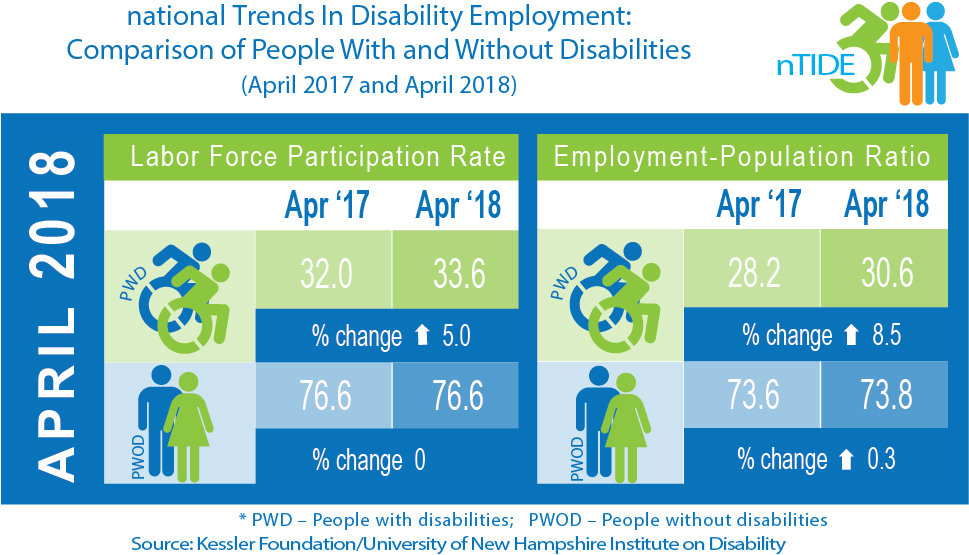nTIDE April 2018 Jobs Report: Tight Labor Market Spurs Unprecedented Job Gains for Americans with Disabilities
Kessler Foundation and University of New Hampshire release nTIDE Report – Monthly Update
East Hanover, NJ – May 4, 2018. Americans with disabilities added another month of job gains, according to today’s National Trends in Disability Employment – Monthly Update (nTIDE), issued by Kessler Foundation and the University of New Hampshire’s Institute on Disability (UNH-IOD). As today’s tight labor market offers greater opportunities for jobseekers with disabilities, there is renewed interest in strategies that help people with disabilities achieve their employment goals.
Individual Placement and Support (IPS) is an evidence-based vocational rehabilitation strategy that is helping people with disabilities achieve their employment goals. Implemented initially in the population with mental health issues, IPS is being tested in individuals with physical disability. Committing resources to evidence-based programs such as IPS will help close the employment gap between people with and without disabilities.
In the Bureau of Labor Statistics (BLS) Jobs Report released Friday, May 4, the employment-to-population ratio for working-age people with disabilities increased from 28.2 percent in April 2017 to 30.6 percent in April 2018 (up 8.5 percent; 2.4 percentage points). For working-age people without disabilities, the employment-to-population ratio increased slightly from 73.6 percent in April 2017 to 73.8 percent in April 2018 (up 0.3 percent; 0.2 percentage points). The employment-to-population ratio, a key indicator, reflects the percentage of people who are working relative to the total population (the number of people working divided by the number of people in the total population multiplied by 100).
“People with disabilities seem to be benefiting from the tight labor market as fewer are actively looking for work and more are becoming employed,” according to John O’Neill, PhD, director of employment and disability research at Kessler Foundation. “Despite the past 25 months of positive change, people with disabilities are still striving to reach their pre-Great Recession employment levels,” he noted. “And we need to keep in mind that there is still a long way to go before people with disabilities achieve employment parity with people without disabilities.”
The labor force participation rate for working-age people with disabilities increased from 32.0 percent in April 2017 to 33.6 percent in April 2018 (up 5 percent; 1.6 percentage points), while the labor force participation rate for working-age people without disabilities remained the same at 76.6 percent. The labor force participation rate is the percentage of the population that is working or actively looking for work.
“It’s really stunning to see the gains made by people with disabilities, and that these gains continue to outpace the gains of people without disabilities. I wish we had monthly data from previous recessions to see if this is something that occurs when the economy is at full employment,” said Andrew Houtenville, PhD, associate professor of economics at UNH and research director of the Institute on Disability.
Fueled by objective evidence, there has been renewed emphasis on employment services for the population with spinal cord injury. A program based on the IPS model is being implemented by the Veterans Administration to help veterans with spinal cord injuries return to work. “To achieve positive outcomes among individuals with severe disabilities, there needs to be close collaboration between providers of vocational services and providers of medical rehabilitation services,” said Dr. O’Neill. “With the goal of placing and supporting individuals in competitive jobs, integrating these services into the rehabilitation is essential to successful programs. The development of policies and partnerships that support the coordination of these services should be a priority.”
In April 2018, among workers ages 16-64, the 4,730,000 workers with disabilities represented 3.2 percent of the total 145,652,000 workers in the US.
The next nTIDE will be issued on Friday, June 1, 2018.
Join our nTIDE Lunch & Learn series today, May 4, at 12:00 pm Eastern. This live broadcast, hosted via Zoom Webinar, offers attendees Q&A on the latest nTIDE findings, provides news and updates from the field, as well as invited panelists to discuss current disability-related findings and events. Deborah R. Becker, MEd, CRC, will join Dr. Houtenville, Dr. O’Neill, and Denise Rozell, policy strategist at AUCD, to discuss the Individual Placement and Support model for advancing the employment of individuals with disabilities. Join live, or watch the recordings at: www.ResearchonDisability.org/nTIDE.
NOTE: The statistics in the nTIDE are based on Bureau of Labor Statistics numbers, but are not identical. They are customized by UNH to combine the statistics for men and women of working age (16 to 64). NTIDE is funded, in part, by grants from the National Institute on Disability, Independent Living and Rehabilitation Research (NIDILRR) (9ORT5022 and 90RT5017) and Kessler Foundation.
About Kessler Foundation
Kessler Foundation, a major nonprofit organization in the field of disability, is a global leader in rehabilitation research that seeks to improve cognition, mobility, and long-term outcomes -- including employment -- for people with neurological disabilities caused by diseases and injuries of the brain and spinal cord. Kessler Foundation leads the nation in funding innovative programs that expand opportunities for employment for people with disabilities. For more information, visit www.KesslerFoundation.org.
About the Institute on Disability at the University of New Hampshire
The Institute on Disability (IOD) at the University of New Hampshire (UNH) was established in 1987 to provide a coherent university-based focus for the improvement of knowledge, policies, and practices related to the lives of persons with disabilities and their families. For information on the NIDILRR-funded Employment Policy and Measurement Rehabilitation Research and Training Center, visitwww.ResearchonDisability.org.
For more information, or to interview an expert, contact:
Carolann Murphy, 973.324.8382, [email protected]